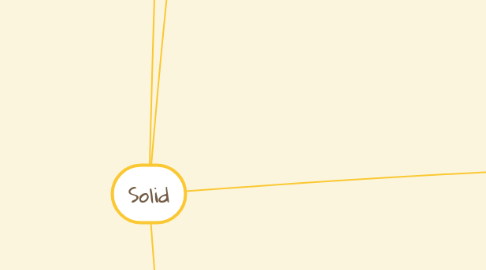
1. Held together by intermolecular forces
2. Properties: Fixed shaped
2.1. -Has strong intermolecular forces
2.2. -Particles closely arranged
2.3. -Rigid arrangement: Cannot move freely
3. Change of phase
3.1. Freezing (solidification) [liquid>solid]
3.1.1. 1) When temperature increase,kinetic energy of molecules decrease
3.1.2. 2) Intermolecular attractions overcome the motion of molecules and strong enough to hold molecules in a fixed (liquid freezed)
3.2. Melting (fusion) [solid > liquid]
3.2.1. 1) A solid is heated
3.2.2. 2) Kinetic energy of the molecules increase.
3.2.3. 3) At certain temperature, kinetic energy strong enough to overcome the intermolecular forces
3.2.4. 4) The particles are free to move (solid start melt)
3.3. Sublimation
3.3.1. - Substance changes directly from liquid to gaseous state
3.3.2. - The solid has weak intermolecular forces.
3.4. Deposition
3.4.1. - Gaseous state to the solid state (Opposite of sublimation)
4. Types of solid
4.1. New Topic
4.1.1. Metalic crystal
4.1.1.1. Formed by metal and made up from the same element linked together by metallic bonds
4.1.1.2. Physicals properties: -High electrical - Luster - Ductile and malleable
4.1.1.3. Example: Na, Mg, Fe
4.1.2. Ionic crystal
4.1.2.1. Composed by positive and negative ions which are held by ionic bonds
4.1.2.2. Physicals properties: - High melting point - Hard but brittle - Only conduct electricity in molten/aqueous state
4.1.2.3. Example: NaCl
4.1.3. Molecular covalent crystals
4.1.3.1. Physicals properties: -Low melting point and boiling point -soft -Poor electrical
4.1.3.2. Example: Iodine
4.1.4. Giant covalent bond
4.1.4.1. Gigantic structure and the atoms linked by covalent bond
4.1.4.2. Example:
4.1.4.2.1. Diamond
4.1.4.2.2. Graphite

